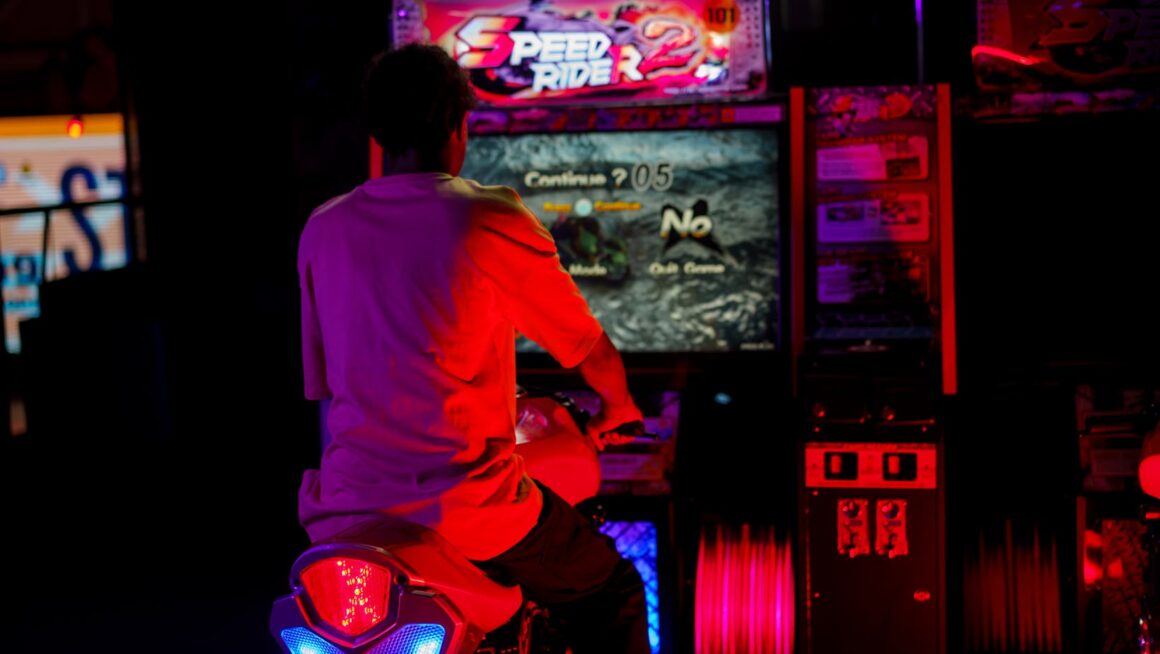Remember the thrill of sitting behind the wheel at your local arcade, the sound of engines roaring in your ears as you navigated through virtual terrains? Racing arcade games have been capturing our hearts and quarters for decades. They’re not just games; they’re a unique blend of skill, strategy, and adrenaline.

Racing Arcade Games
Racing arcade games, captivating and adrenaline-fueled, have a rich history that dates back to the early 1970s. The first generation of these games emerged in 1974 with the release of “Speed Race” by Taito, a game that paved the way for a new era in the gaming industry.
Anchoring firmly on simplicity, “Speed Race” established foundational groundwork for games to follow. In this pioneering game, you’d steer an automobile along a stretch of road while dodging oblivious oncoming cars.
In the late 1970s, Atari’s “Night Driver” became a standout, being one of the first arcade games to demonstrate a first-person perspective. It provided you with the thrill of being in the driver’s seat, experiencing both the pressure and enjoyment of competitive road racing.
The 1980s saw a surge of popularity with the release of titles like “Pole Position” and “Out Run”. “Pole Position”, a product of Namco’s creative brilliance, gave players a taste of real racing excitement. Released in 1982, it introduced a rear-view racer format and became infamous for its challenging gameplay, merging speed with strategic navigation. Similarly, “Out Run”, released in 1986 by Sega, allowed players to select their music, enhancing the personal experience and adding a unique charm to the gaming experience.
Advancements in technology in the late 1980s and 1990s led to games with improved graphics and more sophisticated gameplay. Titles like “Hard Drivin'”, the first game with 3D polygon driving and crash simulations, and “Ridge Racer”, known for its ambient techno music and drifting mechanics, revolutionized the playing field.
The current genera of racing arcade games owe their complexity and immersiveness to the evolution that started decades ago. They carry forward elements from their predecessors, intermixing them with modern tech innovations to deliver heart-pounding gaming experiences.
This rousing journey of racing arcade games demonstrates their enduring allure. With every new release, they continue to captivate global audiences, hold their ground amidst fast-evolving gaming trends, and reaffirm their special place within the thrilling world of arcade gaming.

The Influence of Racing Arcade Games on Pop Culture
Spanning several decades, racing arcade games have imprinted their vivid tire marks on pop culture, shaping trends, influencing media, and fostering a nostalgic sentiment.
Connective threads run between these high-octane games and various prominent media forms, notably movies, television shows, music, and merchandise. A stellar example includes the “Fast & Furious” franchise. Inspired by racing arcade games, it embodies the high-speed chases, spectacular crashes, and strategic boosts that you recognize from games like “Burnout” and “Ridge Racer.”
TV shows, too, have echoed racing arcade themes with series like “Wacky Races” and “Speed Racer,” capturing the competitive spirit and vibrant stylization found in many games. Shows like “Initial D” highlight the connection even deeper, integrating specific arcade games into their narrative.
Music also parallels this influence with numerous artists incorporating racing game soundtracks, effects, and aesthetics into their compositions. Video game soundtracks, like that of “Initial D Arcade Stage” or “Pole Position,” resonate beyond the arcades, shaping the rhythm of pop culture.
Merchandise forms another profound link, with various products like toys, clothing, prints, and even pinball machines wearing racing arcade themes proudly. Your favorite characters, your cherished racing cars, they all come alive off-screen, creating an immersive world that extends beyond mere gaming.
In the social sphere, the influence remains prominent. The multiplayer mode of games like “Mario Kart” often fosters friendly competition and bonding among players, extending its reach beyond the confines of the arcade. Such games, with their universal appeal, have become synonymous with social gatherings and hangouts.

In digital culture, memes and online communities play an important role in promulgating the influence of racing arcade games. Platforms like Reddit and Discord nurture dedicated channels for fans to discuss, share, and celebrate their love for these games.
Overall, racing arcade games have seamlessly hybridized into pop culture, affecting various sectors, hinting at a deep-set and enduring influence. Undoubtedly, their legacy races on, beating to the rhythm of a culture that thrives on speed, competition, and innovation.
